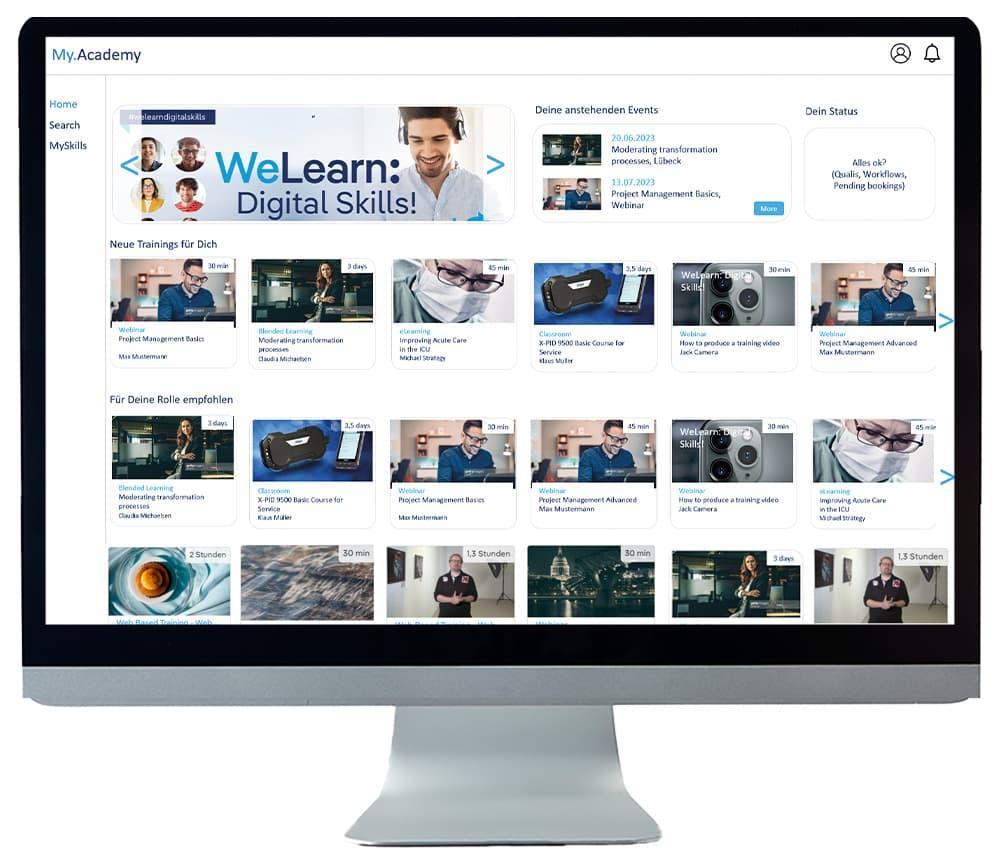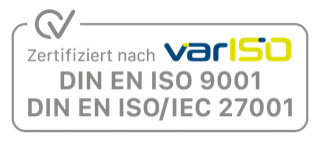How Learning Ecosystems Transform Corporate Learning
From Siloed Systems to Learning Architecture
Learning Ecosystem Essentials in 30 Seconds
A Learning Ecosystem connects tools, content, and processes into a cohesive, learner-centric infrastructure. Organizations benefit from strategically driven development, automated learning paths, and measurable upskilling. It increases transparency, reduces administrative overhead, and empowers self-directed learning. The key is not the number of tools, but their orchestration: taking a holistic approach to learning strengthens organizational resilience and future readiness—regardless of industry or company size.
 Various Perspectives of Learning Ecosystem
Various Perspectives of Learning Ecosystem
Learning Ecosystem as a Driver of Business Success
Boosting efficiency, scalability and skills development across the organization
In today’s fast-paced work environment, traditional learning methods fall short. Fragmented systems, inconsistent processes, and lack of transparency limit access to relevant content and strategic HR management.
A Learning Ecosystem connects technologies, content, processes, and people into a flexible, unified structure. This enables continuous, personalized learning, reduces administrative effort, ensures compliance, and provides real-time insights. Learning becomes a strategic driver of agility and competitiveness.
- Traditional learning approaches reach their limits due to digitalization, demographic change, and agile business models
- Fragmented learning landscapes with many tools, unclear processes, and lack of transparency hinder learning
- Learners struggle to find relevant content, leading to reduced engagement
- HR lacks data-driven control for training and skill development
- Disconnected systems prevent real-time tracking, scalability, and complicate compliance
- Responsibility is spread across departments without clear governance
- A Learning Ecosystem connects tools, content, and people into a unified, flexible structure
- Enables continuous, personalized learning while reducing administrative effort
- Supports strategic management, traceability, and organizational resilience
What Is a Learning Ecosystem and Why Does It Matter?
A Learning Ecosystem is a holistic network of technologies, content sources, processes, and cultural factors that interact to support employee learning and capability building. Unlike isolated tools such as an LMS or an intranet platform, an ecosystem brings different systems together, enabling learners to access formal and informal content seamlessly, while empowering HR and L&D teams with control, transparency, and analytics. It’s not just about implementing multiple tools – it’s about orchestrating them around learner needs and business objectives.
By interlinking learning experiences across platforms and touchpoints, organizations can foster self-directed learning, manage upskilling strategically, and ensure that learning outcomes are aligned with their strategic goals.
- Ecosystems integrate tools, content, data, and processes into a single learning framework
- Learners benefit from unified, user-centered experiences
- Organizations gain insights and control over development processes
Learning Ecosystem: Added Value to Your Company
- Greater transparency on skills and learning progress
- Reduced administrative effort through automation
- Personalized learning for different target groups
- Centralized platform instead of isolated tools
- Stronger employee engagement through continuous development

End-to-End Value: From Content to Capability Building
A Learning Ecosystem enables companies to move from providing content to building capabilities. By aligning learning with business priorities, ecosystems ensure that every development activity contributes to strategic goals. Personalized content increases engagement. Integration of formal and informal learning boosts retention. Automated learning paths and role-based assignments save time. The result is not only individual growth but organizational performance gains.
Whether it’s onboarding, compliance, leadership development, or job-specific training – ecosystems provide the flexibility to meet diverse needs without losing efficiency or coherence.
- Supports all types of learning: onboarding, compliance, skills, leadership
- Ensures alignment between learning and business strategy
- Increases learner autonomy and HR steering ability
Core Components of a Learning Ecosystem and How They Work Together
A Learning Ecosystem consists of several integrated components, each serving a specific purpose in the learning journey. The LMS provides the foundation for structured, mandatory training. The LXP fosters discovery, curation, and personalization. Training management tools automate classroom logistics. Learning portals serve as access hubs. Competency and qualification systems align training with business needs. When well integrated, these components create a seamless experience from need identification to skill validation.
Crucially, it’s the interplay of these systems that creates real value, enabling scalable, personalized learning while offering HR transparency and control.
- LMS: Delivers and tracks mandatory training, definition and automation of processes
- LXP: Enables discovery, personalization, social learning
- Training Management: Automates planning, organisatioin and execution of classroom trainings
- Learning Portal: Unified access point for learners (self-service)
- Qualification Systems: Align training with roles, gaps, and goals
Comparison Table: LMS vs. LXP vs. Learning Ecosystem
| Feature | LMS | LXP | Learning Ecosystem |
| Purpose | Manage formal trainings and compliance courses | Support self-directed, exploratory learning | Combine formal, informal, and strategic learning for skills development |
| Personalization | Limited, mostly role-based | Highly personalized via AI and recommendations | Blends automation and curation for tailored experiences |
| Content Creation | Centralized by admins or external providers | User-generated content and peer sharing possible | Combination of curated, user-generated, and third-party content |
| Learning Analytics | Progress, test results, completions | Engagement, interest, time-on-task | Integrated data view (LRS, skills, behavior, compliance, business impact) |
| Flexibility | Low, standardized processes | High, modular and expandable | Very high: adaptable architecture, easily extendable and scalable |
| Integration | Often closed systems, limited API support | Some APIs, but tool-specific | Fully API-based integration with HR, BI, skills, compliance, and cloud/on-premises systems |
| Target Groups |
HR, Compliance, Administrators |
Employees, social learning, culture builders | All stakeholders: HR, IT, L&D, leadership, employees, business units |
| Governance & Control | Strict rules, administrator-driven | Loose governance, user freedom | Balanced governance: strategy-driven control over content, users, paths and metrics |
| Strategic Impact | Operational (training evidence, compliance) |
Cultural (engagement, informal learning) |
Strategic (skill strategy, talent development, organizational transformation) |
Tailored Learning Architecture with Flexible Ecosystem Components
The true strength of a learning ecosystem lies in its adaptability. Organizations are not limited to one specific learning format, but can flexibly combine formal and informal learning depending on their needs. Highly regulated industries may prioritize audit-proof compliance training, while others focus on exploratory learning, skill development, and collaboration. A modern ecosystem supports both and more.
|
TCmanager® is an example of such a scalable platform. It combines robust qualification management features with the flexibility and innovation of a modern learning culture:
This creates a future-ready learning ecosystem that aligns with organizational goals, existing structures, and individual learning needs – rather than forcing companies to adapt to the system. |
Integration: Why APIs and Interoperability Matter
The effectiveness of a Learning Ecosystem depends on its ability to integrate with other systems. Open APIs and interoperability standards ensure that learning platforms communicate seamlessly with HRIS, content providers, and IT infrastructure. This reduces manual effort, ensures up-to-date data, and supports end-to-end automation – from user provisioning to reporting.
Challenges include inconsistent data models, legacy systems, and unclear ownership. Best practices involve modular architecture, clean interface governance, and close collaboration between IT and HR from the outset.
- Integration with HR systems ensures accurate user data and automation
- APIs connect content libraries, performance tools, and analytics engines
- On-premises/cloud compatibility expands flexibility and future-readiness
Learning Analytics & Reporting – Making Learning Visible
A key advantage of ecosystems is the ability to make learning measurable. Learning Analytics aggregate data from multiple sources into actionable dashboards. This enables better decision-making, supports compliance, and makes ROI visible. Learning Record Stores (LRS) allow tracking of informal and experiential learning. Combined with skill frameworks, this enables organizations to close skill gaps systematically and track progress at individual and team levels.
- Aggregated dashboards improve decision-making
- Learning Record Stores track informal learning and experiences
- Analytics support ROI tracking and strategic planning
Change Management: the Human as a Success Factor
Technology alone doesn’t guarantee success. The introduction of a Learning Ecosystem requires targeted change management. Organizations must manage expectations, communicate clearly, and provide training and support. Typical pitfalls include lack of leadership buy-in, poor internal marketing, and inadequate onboarding. Successful projects involve co-creation, pilot phases, and the use of change agents to drive adoption.
- Clear communication and internal marketing are essential
- Start small: pilot with key user groups
- Champions and change agents support cultural shift
Stakeholders – Who’s Involved and What They Need
A Learning Ecosystem touches multiple stakeholder groups, each with specific goals and concerns. HR focuses on governance and skills. IT ensures security and integration. Business leaders want measurable outcomes. Employees want relevance and ease of use.
Success requires alignment and shared ownership.
- HR: Strategic control, compliance, skills planning
- IT: Integration, data privacy, support
- Employees: Simple access, personalized development
- Leaders: Transparency and strategic fit
Future-Readiness – Your Ecosystem as Innovation Platform
A modern Learning Ecosystem is more than a tool landscape. It’s a strategic foundation for innovation. Technologies like AI, adaptive learning, skills taxonomies, and curated content libraries will continue to evolve. Ecosystems provide the flexibility and openness to integrate new tools and methods as learning and work evolve.
- AI enables dynamic content recommendations and personalization
- Adaptive learning aligns to performance and progress
- Ecosystems can continuously evolve through modular expansion
SoftDeCC - Your Partner for Future-Proof Learning Ecosystems



With more than 25 years of experience in developing and implementing complex learning projects, SoftDeCC supports organizations in building scalable, strategic learning architectures. From the beginning, the focus has been on flexibility, extensibility, and adaptability to the specific needs of each business.
SoftDeCC brings deep project insight across industries - from mid-sized businesses to global enterprises - and understands the technical and organizational challenges involved in ecosystem transformation. The TCmanager® solution is never one-size-fits-all, but always adapted to fit existing processes, systems, and strategic objectives.
SoftDeCC is certified according to ISO/IEC 27001 and ISO 9001, ensuring top-tier standards in both information security and quality management. This gives clients peace of mind regarding data protection, technical reliability, and consistent project excellence.
What sets SoftDeCC apart:
- 25+ years of project experience across industries
- ISO/IEC 27001 certified for robust information security
- ISO 9001 certified: Proven quality management processes
- Strong consulting expertise and deep technical knowledge
- Practical implementation of qualification management, learning analytics, and system integration
- Development "Made in Germany" with short communication paths, personal support, and long-term partnerships
Real-Life Use Cases
Use Case 1: Global Corporation: Lack of Learning Transparency
Initial Situation:
A global technology company with around 45,000 employees in more than 25 countries faced major challenges in corporate learning. Over the years, the learning landscape had become highly fragmented: more than ten different LMS instances, local systems for classroom training, and content managed in various languages.
There was no global overview of learning activities, no centralized reporting, and significant inconsistencies in user experience. Compliance training was tracked manually in Excel, and certificates were sent via email. The IT team struggled with outdated systems and a lack of standardized interfaces.
Solution via Learning Ecosystem:
A centralized Learning Ecosystem was implemented with regionally adaptable components. A global LMS was integrated with a modern LXP to enable personalized learning. Local training tools were connected via open APIs. A Learning Record Store (LRS) was introduced to capture and analyze all learning activities - formal, informal, mobile - centrally. Multilingual content and user interfaces (15 languages) ensured that even non-desk employees (e.g., in production) were reached effectively.
Results:
- 80% reduction in administrative effort for compliance tracking
- Unified global learning analytics and reporting
- 92% user satisfaction in internal survey
- Rollout: 6 months in pilot region, global implementation over 18 months
Case 2: Mid-Sized Manufacturing Company - Gaining Control Over Compliance
A medium-sized mechanical engineering company with 1,200 employees across Germany, Poland, and the Czech Republic lacked a structured training process. Mandatory trainings for safety, data protection, and machinery operation were tracked in Excel. Proof of compliance for audits was unreliable. Group training sessions were the norm, with no training history, no automatic reminders for recurring certifications, and no integration with the HR system.
Solution via Learning Ecosystem:
The company introduced a modular Learning Ecosystem that included:
- A centralized LMS for mandatory and specialist training
- A self-service learning portal with mobile access for shop-floor workers
- Automatic training assignments based on roles and locations (via HR system integration)
- Microsoft 365 integration for single sign-on and calendar syncing
- Automated certificate issuance and supervisor dashboards for compliance monitoring
Results:
- 100% audit-proof documentation of compliance training
- 65% reduction in administrative time
- 30% faster training completion through on-demand offerings
- 98% of mandatory trainings completed on time (up from 68%)
FAQ – Frequently Asked Questions about Learning Ecosystems
1. Do all existing systems need to be replaced?
No. A Learning Ecosystem typically builds on the existing system landscape. What matters is having or creating interfaces that allow systems to be integrated meaningfully. Even older tools can be connected without starting from scratch.
2. Do all components of the learning system need to come from the same vendor?
No. APIs and REST APIs allow systems from different vendors to be seamlessly connected. This enables a fully integrated yet flexible learning environment that can be tailored precisely to the needs of the organization – regardless of the technology provider.
3. How long does it take to implement a Learning Ecosystem?
The timeline depends on the scope and complexity of the project. Pilot implementations can often be completed within 3 to 6 months. A full-scale global rollout typically takes between 6 and 12 months, depending on available resources, IT readiness, and change management.
4. Is a Learning Ecosystem only suitable for large enterprises?
No. Thanks to modular and scalable architectures, powerful solutions can also be implemented for small and medium-sized businesses. Many start with a focused use case such as onboarding or compliance training.
5. What role does the IT department play in the implementation?
IT is a key stakeholder, especially regarding system integration, data security, privacy (e.g. GDPR), and infrastructure. Close collaboration between HR, IT, and business units is critical for successful technical implementation.
6. How can the success and impact of a Learning Ecosystem be measured?
Integrated learning analytics, dashboards, and a centralized Learning Record Store (LRS) allow learning activities to be systematically analyzed. Organizations gain insights into participation rates, skill development, gaps, and return on learning – making learning measurable, manageable, and strategically aligned.

About us
Since 1998 SoftDeCC is working closely with major training centers and academies. This results in a unique experience with training requirements.
Our Learning Management System is designed to adjust to individual corporate learning processes and address evolving challenges. More...
Free Consultancy Appointment

Have questions about implementing a Learning Ecosystem? Our experts take 15 minutes for you – no charge, no obligation.
Call us +49 (0)89 / 3090 839 30 for your free appointment.
More interesting content:





